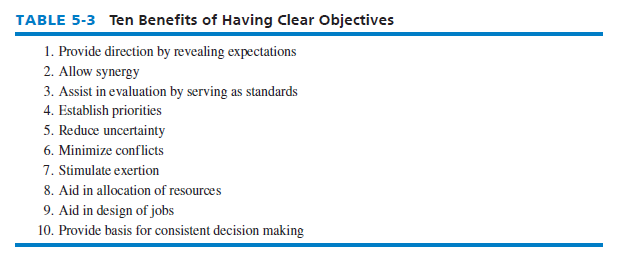Long-term objectives represent the results expected from pursuing certain strategies. Strategies represent the actions to be taken to accomplish long-term objectives. The time frame for objectives and strategies should be consistent, usually from 2 to 5 years. Without long-term objectives, an organization would drift aimlessly toward some unknown end. It is hard to imagine an organization or an individual being successful without clear objectives. You probably have worked hard the last few years striving to achieve an objective to graduate with a business degree. Success only rarely occurs by accident; rather, it is the result of hard work directed toward achieving certain objectives.
Long-term objectives are needed at the corporate, divisional, and functional levels of an organization. They are an important measure of managerial performance. Many practitioners and academicians attribute a significant part of U.S. industry’s competitive decline to the short-term, rather than long-term, strategy orientation of managers in the United States. Arthur D. Little argues that bonuses or merit pay for managers today must be based to a greater extent on longterm objectives and strategies. An example framework for relating objectives to performance evaluation is provided in Table 5-1. A particular organization could tailor these guidelines to meet its own needs, but incentives should be attached to both long-term and annual objectives.

1. Characteristics and Benefits of Objectives
Objectives should be quantitative, measurable, realistic, understandable, challenging, hierarchical, obtainable, and congruent among organizational units. Each objective should also be associated with a timeline. Objectives are commonly stated in terms such as growth in assets, growth in sales, profitability, market share, degree and nature of diversification, degree and nature of vertical integration, earnings per share, and social responsibility. Clearly established objectives offer many benefits. They provide direction, allow synergy, assist in evaluation, establish priorities, reduce uncertainty, minimize conf licts, stimulate exertion, and aid in both the allocation of resources and the design of jobs. Objectives provide a basis for consistent decision making by managers whose values and attitudes differ. Objectives serve as standards by which individuals, groups, departments, divisions, and entire organizations can be evaluated.
Table 5-2 reveals the desired characteristics of objectives, and Table 5-3 summarizes the benefits of having clear objectives.
2. Financial versus Strategic Objectives
Two types of objectives are especially common in organizations: financial and strategic objectives. Financial objectives include those associated with growth in revenues, growth in earnings, higher dividends, larger profit margins, greater return on investment, higher earnings per share, a rising stock price, improved cash flow, and so on; whereas strategic objectives include things such as a larger market share, quicker on-time delivery than rivals, shorter design-to-market times than rivals, lower costs than rivals, higher product quality than rivals, wider geographic coverage than rivals, achieving technological leadership, consistently getting new or improved products to market ahead of rivals, and so on.
Although financial objectives are especially important in firms, oftentimes there is a tradeoff between financial and strategic objectives such that crucial decisions have to be made. For example, a firm can do certain things to maximize short-term financial objectives that would harm long-term strategic objectives. To improve financial position in the short run through higher prices may, for example, jeopardize long-term market share. The dangers associated with trading off long-term strategic objectives with near-term bottom-line performance are especially severe if competitors relentlessly pursue increased market share at the expense of short-term profitability. Amazon, for example, went many years operating without profits but gaining market share. And there are other trade-offs between financial and strategic objectives, related to riskiness of actions, concern for business ethics, the need to preserve the natural environment, and social responsibility issues. Both financial and strategic objectives should include both annual and long-term performance targets. Ultimately, the best way to sustain competitive advantage over the long run is to relentlessly pursue strategic objectives that strengthen a firm’s business position over rivals. Financial objectives can best be met by focusing first and foremost on achieving strategic objectives that improve a firm’s competitiveness and market strength.


3. Avoid Not Managing by Objectives
Mr. Derek Bok, former President of Harvard University, once said, “If you think education is expensive, try ignorance.” The idea behind this saying also applies to establishing objectives, because strategists should avoid the following ways of “not managing by objectives.”
- Managing by Extrapolation —Adheres to the principle “If it ain’t broke, don’t fix it.” The idea is to keep on doing the same things in the same ways because things are going well.
- Managing by Crisis —Based on the belief that the true measure of a really good strategist is the ability to solve problems. Because there are plenty of crises and problems to go around for every person and organization, strategists ought to bring their time and creative energy to bear on solving the most pressing problems of the day. Managing by crisis is actually a form of reacting, letting events dictate the what and when of management decisions.
- Managing by Subjectives —Built on the idea that there is no general plan for which way to go and what to do; just do the best you can to accomplish what you think should be done. In short, “Do your own thing, the best way you know how” (sometimes referred to as the mystery approach to decision making because subordinates are left to figure out what is happening and why).
- Managing by Hope —Based on the fact that the future is laden with great uncertainty and that if we try and do not succeed, then we hope our second (or third) attempt will succeed. Decisions are predicated on the hope that they will work and that good times are just around the corner, especially if luck and good fortune are on our side!2
Source: David Fred, David Forest (2016), Strategic Management: A Competitive Advantage Approach, Concepts and Cases, Pearson (16th Edition).

If some one desires expert view concerning blogging and site-building
then i suggest him/her to go to see this blog, Keep up the fastidious work.
Hi there, just became alert to your blog through Google, and found that it is really informative. I’m going to watch out for brussels. I will appreciate if you continue this in future. Many people will be benefited from your writing. Cheers!